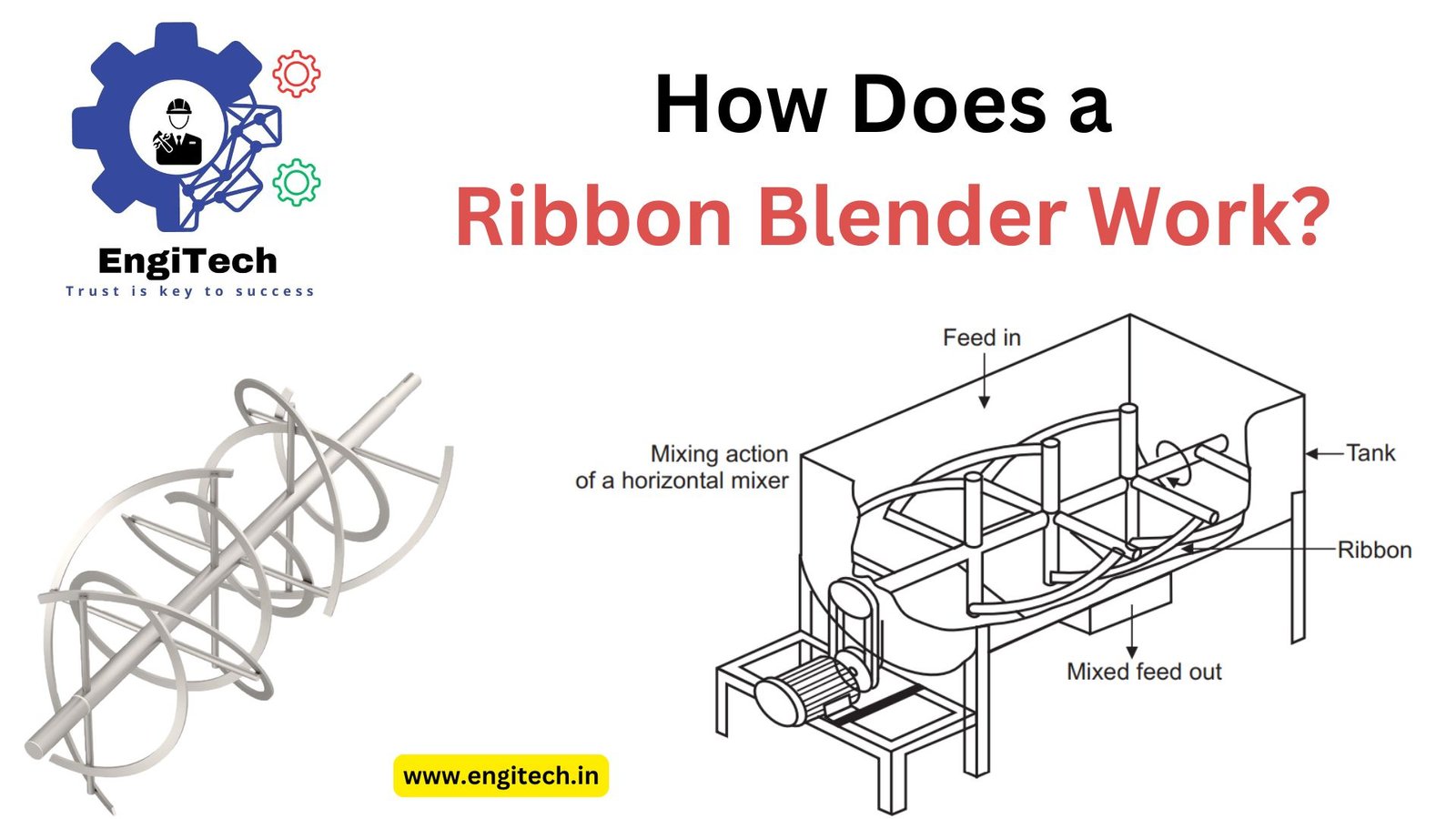Ribbon Blender Working Principle: Detailed Overview

The ribbon blender is a versatile and efficient industrial mixing machine designed for homogenizing powders, granules, and other materials. Its unique working principle combines simplicity with effectiveness, making it a preferred choice in various industries. Here’s a detailed explanation of how a ribbon blender operates:
Key Components That Drive the Principle
Understanding the working principle begins with knowing the main parts of the ribbon blender:
- U-Shaped Trough:
A horizontally oriented vessel that houses the materials for blending. - Helical Ribbon Agitator:
- Made up of two ribbons: inner and outer.
- The inner ribbon pushes materials outward, while the outer ribbon moves them inward, creating a counter-current flow.
- Shaft and Drive System:
- The ribbons are mounted on a horizontal shaft powered by a motor.
- Ensures smooth and consistent rotation.
- Discharge Valve:
Located at the trough’s bottom to release the blended material.
Step-by-Step Working Principle of the Ribbon Blender
- Material Loading:
The materials to be mixed are introduced into the U-shaped trough. These can include powders, granules, or light paste-like substances. - Ribbon Agitator Action:
- Once the motor starts, the shaft rotates the helical ribbons.
- The outer ribbon moves the material from the ends of the trough toward the center.
- Simultaneously, the inner ribbon pushes the material from the center toward the ends.
- This dual movement ensures that all particles are consistently mixed, regardless of their location in the trough.
- Shearing and Tumbling:
- The ribbons’ movement creates a shearing force, breaking down lumps and combining materials without damaging them.
- The tumbling action, where materials are lifted and folded back repeatedly, ensures complete homogenization.
- Mixing Process Completion:
- Depending on the material type and mixing requirements, the process typically takes a few minutes.
- Operators can monitor the mixing progress through observation ports.
- Discharge:
- Once mixing is complete, the blended material is discharged via the bottom valve.
- The design minimizes residue, ensuring a clean and efficient output.
Why the Ribbon Blender Principle Works So Well
The working principle of a ribbon blender is rooted in the opposing flow of materials created by the inner and outer ribbons. This counter-current mechanism ensures:
- Uniform Mixing:
Materials of varying sizes, densities, and compositions are evenly distributed. - Gentle Handling:
Delicate materials are blended without degradation or heat generation. - Efficiency:
The process is quick, consuming minimal energy while delivering consistent results.
Applications of the Ribbon Blender’s Working Principle
The efficiency of the ribbon blender’s working principle makes it indispensable for applications such as:
- Homogenizing spice mixes in food processing.
- Blending active ingredients in pharmaceuticals.
- Preparing fertilizers and chemical powders.
- Combining cosmetic powders for uniform texture.
FAQs About the of Ribbon Blenders
1. How does the ribbon blender achieve uniform mixing?
The ribbon blender uses a dual-helical ribbon agitator that creates opposing material flows. The outer ribbon pushes materials toward the center, while the inner ribbon moves them outward. This counter-current motion ensures thorough and consistent mixing of all ingredients.
2. What types of materials can a ribbon blender mix?
Ribbon blenders are versatile and can mix a wide range of materials, including powders, granules, light pastes, and small amounts of liquid blends. They are particularly effective for dry mixing in industries like food, pharmaceuticals, and chemicals.
3. Is the ribbon blender suitable for delicate materials?
Yes, the ribbon blender’s gentle shearing action makes it ideal for mixing delicate materials without causing damage or degradation. It minimizes heat generation, preserving the integrity of sensitive components.
4. How long does the ribbon blending process take?
The mixing process is typically quick, ranging from a few minutes to around 10 minutes, depending on the material type and desired consistency. The time can be adjusted based on the blending requirements.
5. What role does the discharge valve play in the ribbon blender’s working principle?
The discharge valve is located at the bottom of the trough and allows the blended material to exit efficiently. Its design minimizes residue, ensuring a clean and smooth discharge process, which is crucial for maintaining product quality and reducing waste.
Conclusion
The ribbon blender’s working principle exemplifies the perfect balance between simplicity and functionality. By using opposing ribbon movements, it achieves uniform mixing with minimal energy consumption. Its versatility and reliability make it a cornerstone in industries requiring consistent and efficient mixing processes.
Explore more about industrial blending technologies and expert insights at EngiTech!


